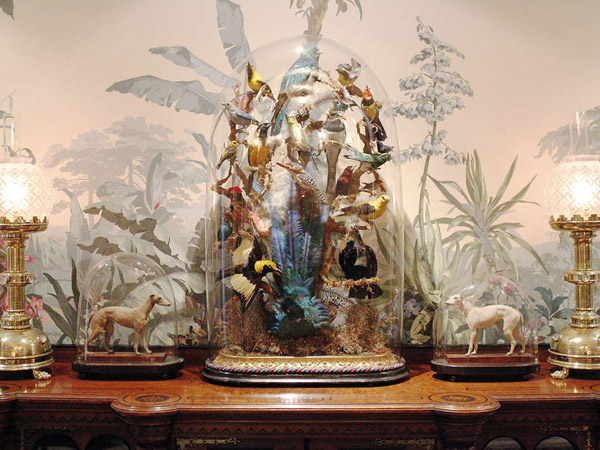Wondrous worlds, under glass
Birds of many different feathers flock together in one of Whitenight's domes.
Forty years ago, friends gave John Whitenight a Christmas present like no other: a Victorian glass dome with three stuffed canaries inside.
He recalls the moment this way: "Boom! It was a dome explosion."
In the decades since, this retired high school art teacher has amassed about 200 of these oddly fascinating pieces, which contain artful, antique displays of flora, fauna, and food made of wax, paper, human hair, wool and muslin, feathers, seashells, and buttons. There are real animals in there, too - not just canaries, but wide-eyed monkeys and goats, huge pheasants and tiny pugs and terriers, forever preserved by the skilled taxidermists that enchanted those nutty Victorians.
"Victorian England was dome central," Whitenight says, but he comes pretty darn close in 2013. His museum-quality collection of "shades," as the domes were known, is displayed in almost every room of his massive home - Victorian-era, of course - in Center City. It is also the subject of his new book, Under Glass: A Victorian Obsession (Shiffer Publishing, $89.99).
Even he has no idea how many other "addicts" are out there. And while there's always a chance more domes are hidden away in some grand country house in England, Whitenight's stash may well be - if anyone's wondering - the largest in the world.
"I would think so," says Hy Myers, a devotee of Victoriana, so named for Queen Victoria, who reigned from 1837 to 1901.
Myers, a noted Philadelphia architect and preservationist, acknowledges that the handblown, removable domes, with their still-life interiors, "may seem weird by today's standards." But understand: The 19th century was an exciting period of exploration, innovation, and experimentation.
"Flowers were being discovered that had never been seen before, and so people began to make them out of wax or shells and then collect them," says Myers, owner of one 18-inch dome containing 30 exotic birds.
Taxidermy, then in its heyday, made it possible for wild animals and beloved pets to be mounted on the wall or secured under glass. Queen Victoria herself had a large collection of stuffed birds preserved with arsenic, in the custom of the day.
But what is it, exactly, that causes all who stand before these strange artifacts to gawk in fascination?
For Whitenight, 61, life partner of attorney Frederick M. LaValley, there is no small measure of self-identification.
Growing up in Catawissa, Columbia County, where his German ancestors settled in 1730, he says, "I always felt like an exotic creature. I was always thinking what was I doing there and how soon could I get out of there?
"The song from Sweet Charity, 'There's Got To Be Something Better Than This,' really resonated."
Whitenight believes others are simply attracted to the domes' "organic earthiness," a quality increasingly found in contemporary decorative arts, or to their aura of nostalgia and romanticism.
"It's very come-hither. Look all you want but you can't touch," Whitenight says, "and, being an artist, I can't help but be drawn to things that are beautifully made."
That beauty is not cheap; domes, which range from 4 inches to four feet high, sell privately or at auction for as much as five figures.
Many are quite whimsical, such as the lobster-shell figures or the two frogs playing pool. "Monkey Riding the Goat" is at first entertaining, then unsettling, once you learn from Whitenight that the goat was killed colliding with a team of horses and the monkey died of shock when its irritated owner threw a bucket of ice water over him.
Some scenes are downright horrific, such as the hapless American settler being scalped by Indians or the doomed prisoner at the guillotine. (With the pull of a tiny pin, the head actually drops into a basket.) But most domes are just plain gorgeous, jewellike mosaics of flowers, birds, and fruit.
Alexandra Kirtley, associate curator of American decorative arts at the Philadelphia Museum of Art, thinks the domes "represent something about bringing nature inside" and the tendency of people to "always look for a way to bring art into their home."
"This is one of the ways it was accomplished in the 19th century," she says.
Victorians also liked to collect, study, and display their knowledge and creativity. "I personally think it's really interesting to take lots of little shells and make one big picture. It's a mosaic. That is exciting to me.
"And the way the birds are shown . . . they are not static, not still. They are very much alive," Kirtley says.
And very much about the importance of the Victorian parlor as the center of family life.
Domes were practical, too. They kept poking fingers out and dirt, soot, and dust away. Victorian homes had gaslights, coal fires, and no screens; outside, the streets were filthy with mud, dust, and manure.
These days, glass domes are popular showcases for everything from artwork and dried wedding flowers to books and model boats, and taxidermy is celebrated by decorator-in-chief Martha Stewart. As Timothy Rub, art museum director, writes in the foreword to Under Glass: "Parlor domes have the power to excite us as much today as they did the Victorian audiences for whom they were made."
(Rub was traveling in Asia and could not be reached.)
Whitenight certainly agrees. He also worries that the fun of collecting objets d'art is being lost, as each new generation becomes more "hermetically sealed" in a world of handheld reality and online intimacy.
Soon, it may be we humans who are untouchable, sealed off, virtually under glass.
>Inquirer.com
To see more of John Whitenight's dome collection, go to www.inquirer.com/ginnyvsmith@phillynews.com
215-854-5720
facebook.com/InqGardening
@inkygardener
www.inquirer.com/kisstheearth
Read more at http://www.philly.com/philly/home/20131115_Wondrous_worlds__under_glass.html#XEOcajkphLVmAkV6.99


No comments:
Post a Comment